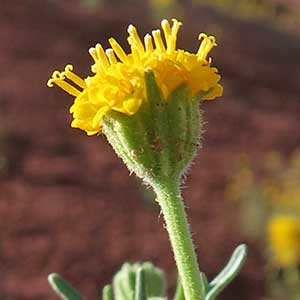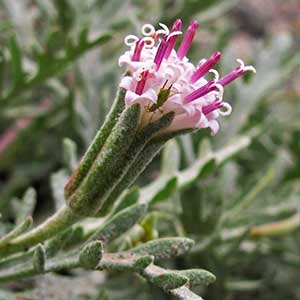Chaenactis nevii
Chaenactis thompsonii
John Day pincushion, John Day's pincushion, Nevius' chaenactis
Thompson's pincushion
mostly 1–3;
branches mainly distal.
mostly 5–15+, ascending to erect.
basal (withering) and cauline, 2–5 cm;
largest blades ± elliptic, ± plane to 3-dimensional, not succulent, 1–2-pinnately lobed;
primary lobes mostly 3–8 pairs, ± remote, ultimate lobes ± plane to involute.
mostly cauline, 2–5 cm;
largest blades ± elliptic, ± plane, 1-pinnately lobed;
lobes mostly 2–5 pairs, remote, ± plane.
1–6 cm, distally stipitate-glandular and, sometimes, ± arachnoid to villous.
ascending to erect, 2–5 cm.
± hemispheric to campanulate.
± obconic.
corollas bright yellow, 4–6.5 mm;
peripheral corollas ± erect, actinomorphic, scarcely enlarged.
7–9 mm.
longest 6–9 mm;
outer predominantly stipitate-glandular and, sometimes, ± arachnoid to villous in fruit, apices ± erect, acute, rigid.
longest (10–)12–15 mm;
outer closely lanuginose, not stipitate-glandular, apices erect, ± rigid.
mostly 3–9 per stem.
mostly 1–3 per stem.
3.5–6 mm (compressed);
pappi 0 or coroniform (of ± 10 scales, longest 0.1–0.5 mm).
7–9 mm (eglandular);
pappi: longest scales 3.5–5 mm.
= 12.
Chaenactis nevii
Chaenactis thompsonii
Chaenactis nevii is known from the John Day Basin area in Gilliam, Grant, Jefferson, Wasco, and Wheeler counties. This odd and isolated species combines traits of C. artemisiifolia (sect. Acarphaea) and C. glabriuscula, and might be descended from their common ancestor.
(Discussion copyrighted by Flora of North America; reprinted with permission.)
Of conservation concern.
Chaenactis thompsonii appears to be sister to C. evermannii; it is known from the mountains of central and northwestern Washington. The similar habits of C. thompsonii and C. ramosa (= C. douglasii var. douglasii) appear to result from convergent evolution in the distinctive habitat of their type localities (Wenatchee Mountains), not from a close genetic relationship as suggested by Cronquist.
(Discussion copyrighted by Flora of North America; reprinted with permission.)



